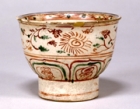Asian Gallery (Toyokan) Room 3
May 8, 2008 (Thu) - July 27, 2008 (Sun)
This thematic display features Southeast Asian lacquer ware and ceramics which were imported to Japan during the Edo period (1603-1868) and favored in the world of the tea ceremony.
Kinma is a decorative lacquer art technique, in which a design is line-engraved on the lacquered surface and later filled with colored lacquer. The name Kinma is derived from the Thai words chien mahk, a Southeast Asian custom of chewing (chien) betel nuts (mahk) mixed with quicklime and wrapped in a vine leaf. Vessels used for chien mahk were decorated in kinma and were imported to be used as tea powder containers or for the delicacies served as an accompaniment.
Around the same time, Japanese tea masters became fond of a type of Southeast Asian ceramic ware. This was Vietnamese enameled ware known as "Red Annamese Ware" which is made of reddish brown clay covered with white slip and colorless transparent glaze and decorated with painted designs of flowers, deer, cows, birds, and others, by specialist craftsmen in overglaze enamel. It has a unique charm, distinct from that of the Chinese or Korean ceramics.
Kinma is a decorative lacquer art technique, in which a design is line-engraved on the lacquered surface and later filled with colored lacquer. The name Kinma is derived from the Thai words chien mahk, a Southeast Asian custom of chewing (chien) betel nuts (mahk) mixed with quicklime and wrapped in a vine leaf. Vessels used for chien mahk were decorated in kinma and were imported to be used as tea powder containers or for the delicacies served as an accompaniment.
Around the same time, Japanese tea masters became fond of a type of Southeast Asian ceramic ware. This was Vietnamese enameled ware known as "Red Annamese Ware" which is made of reddish brown clay covered with white slip and colorless transparent glaze and decorated with painted designs of flowers, deer, cows, birds, and others, by specialist craftsmen in overglaze enamel. It has a unique charm, distinct from that of the Chinese or Korean ceramics.

